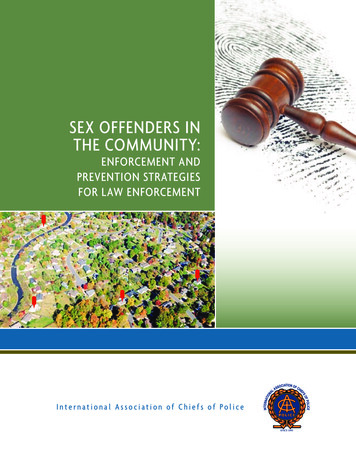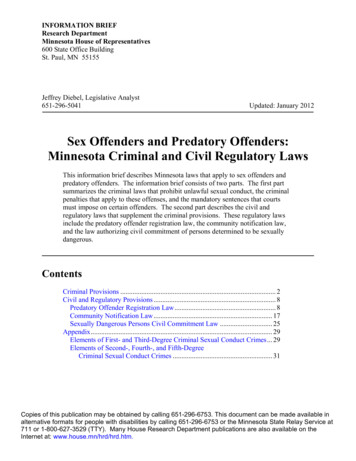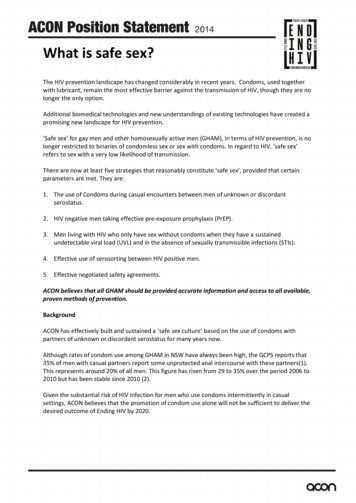
Transcription
Sex Offenders inthe Community:Enforcement andPrevention Strategiesfor Law EnforcementInternational Association of Chiefs of Police
For more information on sex offender management related projects or resources,please contact Alissa Huntoon at 1-800-843-4227 Ext. 812 or huntoon@theiacp.org,or Christina Horst at 1-800-843-4227 Ext. 830 or horstc@theiacp.org.Date published: September 2007
I n ter n at i o nal Asso c iatio n o f Chie fs o f Po liceTABLE OF CONTENTSExecutive Summary4Introduction7The Sex Offender Population: Perceptions and Realities9Enforcement and Prevention Strategies12Multi-Agency Partnerships and Collaborative EffortsOffender TrackingUse of Technology: Databases, Web Sites, and SoftwareCommunity EducationOfficer Education and TrainingEmerging Issues19Residency RestrictionsHomeless Sex OffendersInterstate Movement of Sex OffendersExamples from the Field: Law Enforcement Agency ProfilesBedford County Sheriff’s Department (Virginia)Cary Police Department (North Carolina)Dallas Police Department (Texas)Lake Havasu City Police Department (Arizona)Lafourche Parish Sheriff’s Office (Louisiana)Palm Beach County Sheriff’s Department (Florida)Port Orange Police Department (Florida)Prince William County Police Department (Virginia)San Diego Community College Police (California)San Diego Sex Offender Management Council (California)Seattle Police Department (Washington)Two Rivers Police Department (Wisconsin)22Additional Resources46Reference Materials46Sample Forms and Documents47 1
Se x O f fen d er s i n t h e Com m u n i t y: E nfo rce me nt and P reve ntio n S trate gie s fo r Law E nfo rce me ntACKNOWLEDGMENTSInternational Association of Chiefs of PoliceFounded in 1893, the International Association of Chiefsof Police (IACP) is the world’s oldest and largest nonprofitmembership organization of police executives, with morethan 21,000 members in 100 different countries. IACP’sleadership consists of the operating chief executives ofinternational, federal, state, and local agencies of all sizes.The association’s goals are to advance the science and art of police services; develop and disseminate improved administrative,technical, and operational practices and promotetheir use in police work; foster police cooperation and the exchange ofinformation and experience among policeadministrators throughout the world; bring about recruitment and training in the policeprofession of qualified persons; and encourage adherence of all police officers to highprofessional standards of performance and conduct.This project is supported by grant number 2006WP-BX-K005 awarded by the Bureau of JusticeAssistance. The Bureau of Justice Assistance isa component of the Office of Justice Programs,which also includes the Bureau of Justice Statistics, the National Institute of Justice, the Officeof Juvenile Justice and Delinquency Prevention,and the Office for Victims of Crime. Points ofview or opinions in this document are those ofthe International Association of Chiefs of Policeand do not represent the official position or policies of the Department of Justice.We would like to express our sincere gratitude tothe leadership and staff of the following agenciesfor sharing their time and expertise:w Bedford County Sheriff’sDepartment (Virginia)w Cary Police Department (North Carolina)w Dallas Police Department (Texas)w Lake Havasu City PoliceDepartment (Arizona)w Lafourche Parish Sheriff’s Office (Louisiana)w Palm Beach County Sheriff’sDepartment (Florida)w Port Orange Police Department (Florida)w Prince William County PoliceDepartment (Virginia)w San Diego Community CollegePolice (California)w San Diego Sex Offender ManagementCouncil (California)w Seattle Police Department (Washington)w Two Rivers Police Department (Wisconsin)w Virginia Department of Corrections, Divi-sion of Community CorrectionsWe extend a special thank you to the followingindividuals for their review and contributions tothis document: Chief Scott Cunningham, Cary,North Carolina, and Chief Thomas Tremblay,Burlington, Vermont. 2
Executive Summary 3
Se x O f fen d er s i n t h e Com m u n i t y: E nfo rce me nt and P reve ntio n S trate gie s fo r Law E nfo rce me ntSince November 2005, thew increasing regular communication amongall agencies responsible for sex offenderInternational Association of Chiefs of Police(IACP) has been working in partnership with theBureau of Justice Assistance (BJA) to learn aboutand understand law enforcement’s role in sexoffender management, to identify policy andoperational challenges facing law enforcementregarding sex offenders, to design and develop resources to assist police managers, and to enhanceagency efforts to hold sex offenders accountableand reduce future victimization.management activities,w establishing the necessary infrastructure tocomply with mandated registration andverification requirements, andw assessing an offender’s risk to reoffend.The purpose of this publication is to help filloperational gaps and to provide examples ofhow various law enforcement agencies across thecountry employ strategies to better safeguardcommunities from sex offenders. This guidebookOur initial efforts focused on examining how lawenforcement agencies engage volunteers to support and strengthen sex offender managementactivities. Volunteers play a significant role inenhancing law enforcement’s ability to maintainpublic safety and to comply with sex offendermandates. Volunteers support agencies with registration, records management process, maintenance of paper and electronic files, and outreachto criminal justice and public safety agencies toeducate the community, represent victims, andshare information.w provides an overview of the sexoffender population,w identifies law enforcementprevention and enforcement strategies,w features specific examples fromjurisdictions around the country, andw includes sample forms and documents.Law Enforcement ResourcesIn addition to this publication, the IACP isdeveloping multiple products and resources toenhance the law enforcement response to sexoffenders in the community. Please contact theIACP for information on upcoming resources:Using volunteers is just one effective law enforcement approach. Law enforcement is also creating specialized units and forging partnerships tofurther enhance and strengthen their capacity tomonitor and track sex offenders in the community. Despite these active efforts and as a resultof the growing focus on sex offenders, manystate, local, and tribal law enforcement agenciesare struggling to address a myriad of policy andoperational issues including, but not limited tow An IACP model policy on sex offendersw Two publications in partnership with theAmerican Probation and ParoleAssociation (APPA): Guidelines for information sharing between law enforcement and corrections(what information corrections officialshave, how to access it, and how it willstrengthen enforcement and preventionefforts), andw tracking convicted sex offenders not underformal/community supervision,w compiling and collecting key informationand documents for comprehensiveinvestigations, Advantages and disadvantages of electronic monitoring technology used totrack sex offenders.w responding effectively to community fearsand concerns about sex offenders living in their neighborhoods, 4
I n ter n at i o nal Asso c iatio n o f Chie fs o f Po lice w Framing A Law Enforcement Response:Addressing Community Concerns about SexOffenders, a pamphlet that provides law enforcement with talking points to considerin framing an agency response to questionsposed by the community.w A Web cast on risk assessment tools. 5
INTRODUCTION 6
I n ter n at i o nal Asso c iatio n o f Chie fs o f Po liceSex offenders and theircrimes pose a threat within communitiesagencies and that nearly 60 percent of these sexoffenders were under conditional supervision inthe community.and can create an atmosphere of fear. State, local,and tribal law enforcement agencies shoulderthe responsibility for keeping communities safefrom repeat and predatory sexual offenders. Lawenforcement responsibilities includeThose sex offenders that are no longer under correctional or community supervision, but are stillsubject to registration and monitoring oversightare of grave concern to law enforcement. Further,law enforcement is deeply concerned about sexoffenses that are not reported to the police andsex offenders yet unknown in the community.This backdrop makes law enforcement’s task toeducate and safeguard communities muchmore difficult.w informing the community of the presenceof registered sex offenders,w verifying compliance with registration laws,w locating noncompliant orabsconded offenders,w investigating violations of such laws andnew sex offenses,w responding to victims of sex crimes, andw educating the community about personalsafety precautions and crimeprevention activities.Law enforcement’s sex offender oversight responsibilities have increased greatly over the pasttwo decades and continue to grow rapidly with arecent swell of federal and state legislation, andhigh-profile cases involving sex offenders. Withthe passage of the Adam Walsh Child Protection and Safety Act (Walsh Act), by July 2009 lawenforcement agencies will be required to investsubstantial human resources to comply with theWalsh Act’s registration, tracking, notification, andmonitoring mandates.The National Center for Missing and ExploitedChildren (NCMEC) estimates that there are morethan 602,000 registered sex offenders in theUnited States and its territories (May 2007). Nocurrent statistics exist for the number of theseregistered sex offenders under some form of correctional or community supervision. The most recent statistic from the Bureau of Justice Statisticsestimated that in 1994 approximately 234,000 offenders convicted of rape or sexual assault wereunder the care, custody, or control of corrections 7
THE SEX OFFENDER POPULATION:PERCEPTION AND REALITIES
I n ter n at i o nal Asso c iatio n o f Chie fs o f Po liceWhen a sex offender isreleased back into thecommunity, it can be an overwhelm-enforcement agencies have wide discretion indeterminingw how public notification happens and when,ing and frightening experience for the neighborhood. The widely used “sex offender” labelimplies that all sex offenders are the same andcontributes to the public’s fear about sex offenders integrating back into the community. Lawenforcement agencies are in a unique position toaddress and alleviate such community concerns.Understanding that sex offenders are not a homogeneous population is critical to any enforcement or prevention strategy and will enhance anagency’s ability to target their resources towardthose offenders presenting the greatest risk tothe community.w what information communities receive, andw who gets notified.Because notification practices vary greatly between jurisdictions, public misperceptions existas to whom sex offenders are. Research studiesby state and federal government agencies andvictim advocacy organizations reveal that mostvictims of sex crimes are known to the offenderand that a majority of sex offenses are committed against family members, friends, or closeacquaintances. Despite this reality, mass mediareports of horrific stranger abductions fuel community fears. While these abhorrent crimes occur,law enforcement must balance resources tomonitor a large percentage of registered sex offenders who are categorized as a lower risk to thecommunity while remaining vigilant to high-riskand violent sexual offenders.A significant amount of research about the sex offenderpopulation is available from the Center for Sex OffenderManagement (CSOM). CSOM is a national project that supports state and local jurisdictions in the effective management of sex offenders under community supervision. CSOMprovides studies and statistics about who commits sexcrimes, general characteristics, recidivism rates, offendingpatterns and grooming behaviors, and offers sex offendermanagement related resources, such as communityeducation curriculums.WEB SITE: WWW.CSOM.ORGThis section outlines general perceptions andrealities about sex offenders. However, it is important to keep in mind that this information isbased on available statistics of reported crimes.Research has shown that a large percentage ofsex crimes are not reported to the police.Perception: All sex offendersare alike.In the 1990s, to enhance community safety,community notification laws were passed withthe intention of sharing relevant and necessaryinformation for the public’s protection from convicted sex offenders. Recognizing the diversity ofsex offenders and sex offenses, the format anddelivery of community notification is generally tailored to the “risk level” of an offender. Amajority of states use risk assessment tools andclassification systems to determine a risk levelwhich corresponds to the extent of informationshared with the public. Minimum standards forcommunity notification exists, but in general lawReality:Sex offenders can be male or female, rich or poor,employed or unemployed, religious or nonreligious, highly educated or uneducated. There isno established sex offender profile, which meansthat no one characteristic is indicative of a sexoffender or sexual misconduct. However, we doknow that many sex offenders exhibit commoncharacteristics such as denial and minimization,poor coping skills, deviant sexual behavior, andmultiple victims and offenses. 9
Se x O f fen d er s i n t h e Com m u n i t y: E nfo rce me nt and P reve ntio n S trate gie s fo r Law E nfo rce me ntPerception: All sex offenderswill eventually recidivate.registerable offense. Additionally, the likelihoodof victimization depends largely on the type ofcrime, as well as characteristics of the sex offender’s relationship to the victim.Reality:w According to the 2000 Sexual AssaultRecidivism rates for sex offenders are inconsistent due to methodological difficulties (variabilityin sample sizes, differences in follow-up lengths,and sample demographics). However, most studies suggest that how likely a sex offender is to reoffend depends on the type of crime committed,as well as victim characteristics and relationships.Research has identified various static (unchangeable) and dynamic (subject to change) risk factorsthat tend to predict whether or not a sex offender will reoffend. CSOM outlines examples ofboth static and dynamic risk factors.of Young Children as Reported to LawEnforcement, 93 percent of juvenile sexualassault victims knew their attacker, 34 percent were family members, and 58 percentacquaintances. Only 7 percent of perpetrators were strangers to the victim.w A 1998 National Violence against WomenSurvey revealed that among women thatreported being raped, 76 percent werevictimized by a current or former husband,live-in partner, or date.w A study done by the Bureau of Justice Sta-Static risk factors: prior convictions for sexcrimes, targeting male victims, a younger age ofonset of sex offending, being unmarried, havingan antisocial personality disorder, or having unrelated, unfamiliar victims.tistics found that 9 out of 10 rape or sexualassaults involved a single offender withwho the victim had a priorrelationship as a family member, intimatepartner, or acquaintance.Dynamic risk factors: intimacy problems, increased hostility, emotional identification withchildren, preoccupation with sexual matters, unstable lifestyle (employment, housing, substanceabuse), demonstrating noncompliance with supervision or treatment expectations, or justificationof deviant behavior.Perception: Treatment of sexoffenders is ineffective.Reality:The success of treatment for sex offenders ishighly debated. Newer practices that involvetreating sex offenses like a chemical addictionand contemporary cognitive behavioral treatment are showing some promise (2007). Offenders are taught to control their behavior througha tailored approach focused on changing theirthoughts, taking responsibility, and avoiding certain triggers (people and places) that may causethem to reoffend. Treatment and the certaintyof negative consequences (such as arrest andincarceration) may motivate offenders to controltheir behavior. Based on multiple research studies,CSOM states that “treatment programs can contribute to community safety because those whoattend and cooperate with program conditionsare less likely to reoffend than those who rejectintervention.”Perception: The registered sexoffender living down thestreet is the biggest threat tothe community.Reality:Being informed of a registered sex offender inyour community can help you to protect yourself and your family; however, the majority ofsex crimes do not get reported to the police andare committed by someone known to the victim(family, friend, or acquaintance). Sex offenderslisted on a registry represent only those offenders that were reported and then convicted of a 10
ENFORCEMENT ANDPREVENTION STRATEGIES 11
Se x O f fen d er s i n t h e Com m u n i t y: E nfo rce me nt and P reve ntio n S trate gie s fo r Law E nfo rce me ntThe responsibility formonitoring and supervising sex offenders in the community fallsof formal partnerships must be adaptable to thecommunity and social environment.Law Enforcement and CorrectionsPartnershipswith no one agency. Multiple disciplines play apart in the management of sex offenders from incarceration to treatment to compliance; all working toward the goals of reducing recidivism andprotecting citizens from potential victimization.State, local, and tribal law enforcement agencies are critical partners in a comprehensive sexoffender management strategy. While laws andordinances direct law enforcement efforts, manyagencies adopt their own policies and proceduresto enhance community safety. For example, manyagencies elevate their enforcement and prevention efforts by conducting a wide range of activities includingLaw enforcement and corrections officials commonly forge partnerships to aid in the oversightof sex offenders released back into the community. These partnerships evolve for investigative andcase management reasons. At intake, correctionsofficials obtain in-depth information about anoffender, including details about his/her crimes,victims, and history of sexual deviance. Thisinformation is valuable to law enforcementbecause it affords police agencies the opportunity to better assess risk to the community. Uponreentry, many sex offenders remain on activesupervision under the auspices of local probationand parole.w face to face address verification checks,w supplemental risk assessments,Law enforcement and corrections officialspersonnel can work together to hold sex offenders accountable and decrease the likelihood ofnoncompliance or absconding. These partnerships can serve as a “checks and balance” system,reinforcing that multiple agencies are communicating and involved to ensure success within thecommunity and compliance with supervision andlegislative requirements.w regional task forces and multi-agencypartnerships, andw ongoing community education.Managing sex offenders is complex and multifaceted; therefore, a law enforcement approach thatinvolves multiple approaches may be necessary.The following section summarizes the variousstrategies currently in use by law enforcementacross the country.Multi-Disciplinary Task ForcesMULTI-AGENCY PARTNERSHIPSAND COLLABORATIVE EFFORTSMulti-disciplinary task forces may comprise lawenforcement, corrections, judicial personnel,victim advocates, treatment providers, educational professionals, and other community serviceproviders. The ultimate goal of a task force is toprovide a multi-faceted approach to the supervision, registration, and treatment of sex offendersin the community to improve public safety andreduce victimization. Task forces may be appointed to critically evaluate the current state ofsex offender management and to develop recommendations and pinpoint policy and proceduralareas for future consideration. Other task forcesA major component of supervising sex offenders within the community includes collaborativeefforts and partnerships among law enforcement,community, and other criminal justice agencies. Agencies report that the greatest benefit ofcollaboration is the broad perspective and theimproved ability to collectively manage sex offenders. Establishing a common goal among agencies will direct efforts of the group and provide asense of validation for all participating agencies.To sustain collaborative efforts, the composition 12
I n ter n at i o nal Asso c iatio n o f Chie fs o f Po liceattempted abduction data, online predator data,and child abduction data for potential linkageswith noncompliant sex offenders sought by lawenforcement and to examine trends and patterns.This information will be used to broaden theexisting knowledge base regarding sex offendersand child predators in order to create more effective prevention and response strategies.have been created to locate and apprehend noncompliant offenders.Many task forces span all levels of government.Some regional and local task forces work withthe United States Marshals Service (USMS) to apprehend noncompliant sex offenders. The WalshAct specifically tasks the USMS with assistingjurisdictions in locating and apprehending sexoffenders who violate sex offender registrationrequirements. The Walsh Act makes it a federalfelony punishable by a 10 year imprisonment forsex offenders who fail to register and who travelbetween states. The USMS has established the“Sexual Predator Crimes Branch” to assist locallaw enforcement agencies in locating and apprehending noncompliant sex offenders.Benefits of multi-agency partnerships Improved intelligence gathering and informationsharing efforts, Increased capacity to develop collaborative responses, Enhanced supervision of offenders, Increased offender accountability (i.e., sends clearmessage to offenders that he/she will beheld accountable), Enhanced efficiency and effectiveness of participatingagency’s operations and processes, and Focused on reducing victimization and recidivismwithin communities.Additionally, the National Center for Missingand Exploited Children (NCMEC) partners withthe USMS to serve as a central information andanalysis hub assisting in their efforts to apprehend noncompliant registered sex offenders. TheSex Offender Tracking Team is made up of analysts dedicated to supporting the USMS, FederalBureau of Investigation (FBI), state sex offenderregistries, and other state and local law enforcement nationwide to assist in identifying andlocating noncompliant registered sex offenders.These analystsOFFENDER TRACKINGAddress VerificationThe Walsh Act expands the number of registerable sex offenses and requires a broader group ofsex offenders to register for longerperiods of time, many for life. Verifying residential addresses provided through national andstate sex offender registries is a serious task.Physically sending an officer to verify or confirm aregistered sex offender’s address is referred to ascompliance or verification checks. Certain statesmandate that law enforcement conduct physicaladdress verifications for certain registered sexoffenders on a specified timetable (for example,once a year for lower risk levels and as often asfour times a year for the highest risk level).w serve as liaisons between state registries inan effort to increase communication andbetter track sex offenders movingbetween states,w respond to requests to conduct searchesto assist law enforcement agenciesand state registries in their investigationsof noncompliant/absconded sexoffenders, andw provide agencies with lead packages toassist them in the location andapprehension of these fugitives.Depending on the state, the mandated responsibility may lie with a police department, sheriff’s office, or state police. However, some lawIn addition, this team will be comparing NCMEC’s 13
Se x O f fen d er s i n t h e Com m u n i t y: E nfo rce me nt and P reve ntio n S trate gie s fo r Law E nfo rce me ntenforcement agencies have leveraged internal andexternal resources to enable them to conductaddress verification checks, even if not requiredby law, because these checks increase offenderaccountability and provide an additional publicsafety service. Departments that provide supplemental address verification checks are mindful ofthe rights of the offender and develop appropriate procedures so as not to harass the individual.fender’s level of risk and each includes a numberof variables and different types of analyses.Sex offenders vary in reoffense patterns and areresponsive to different types of supervision andtreatment. Valid and accurate risk assessmentsallow law enforcement to allocate resources tothose offenders posing the greatest threat tothe community. For example, Texas has recentlyannounced plans to implement new methods forassessing and categorizing risk levels of registeredsex offenders. The new tool will be designed toprovide a better indication of which offenderspresent the highest risk to the community.The process for performing address verification checks varies from state to state; severalexamples of local agencies are included in thispublication. Some law enforcement agencies perform face-to-face checks; others use a mail-basedprocess. Conducting checks allows the agency tocollect additional information such as changesin appearance, the offender’s employment andschool status, and registered vehicles.Compliance checks function as a type of riskassessment based on information released bythe offender and officer observations during thevisit. A wealth of information is available to lawenforcement through compliance checks if thesevisits are used for more than confirming an address or place of employment.Benefits of conducting address verifications Opens the lines of communication between lawenforcement and the offender, Allows the officer to recognize changes in offender’sappearance or a deterioration in the offender’s condition, Documents contact and updated information onthe offender, Establishes an understanding with other members of thehousehold who may serve as a resource if issues arise, Sends a clear message to the offender that he/she will beheld accountable.Some law enforcement agencies create supplementary internal risk assessment questionnairesor forms allowing them to collect more lawenforcement-specific information and to maintain thorough investigative files. Sex offenderbehavior and risk to the community can change;therefore, continued contact with these individuals, particularly unsupervised offenders, can alertpolice to such changes.Benefits of risk assessment Improves the ability to delegate resources to thoseoffenders classified as high-risk (increase verificationchecks, increase registration frequency), Provides an investigative resource if sexual offenses orchild abductions occur in the jurisdiction, and Creates a better understanding of the offender’s behavior.Risk AssessmentsA risk assessment provides critical information tolaw enforcement by measuring the extent, nature,and seriousness of an offender’s sexual behavior,the degree of risk or threat the offender poses tothe community, and the general dangerousness ofthe offender in different settings. The theory isthat sex offenders who pose a higher risk to thecommunity are subject to a higher level of supervision. Different types of risk assessment toolsuse objective measures to determine a sex of- 14
I n ter n at i o nal Asso c iatio n o f Chie fs o f Po liceUSE OF TECHNOLOGY: DATABASES,WEB SITES, AND SOFTWAREcommunity” based on the belief that “furnishingthe public with information regarding convictedsex offenders is a critical step toward encouragingthe public to protect themselves from potentialfuture acts.” The Seattle Police Department’sWeb site (www.cityofseattle.net) lists extensiveinformation on crime prevention, sex offenderfacts, how to talk to children, characteristics andbehaviors of pedophiles, and a list of commonlyasked questions.Technology serves as an integral component ofmany law enforcement prevention and enforcement strategies. Computer aided dispatch (CAD)software, national and state sex offender registries, and agency Web sites advance the abilityof law enforcement to monitor and track sexoffenders, provide the public with importantsafety information, and notify citizens when a sexoffender moves into their neighborhood.Benefits of Technology CAD software increases the ability of law enforcement tomonitor and track sex offenders in the community, functions as an investigative resource, and improves officersafety and response time; Public registries assist law enforcement in locatingabsconders and inform citizens when a sex offender hasmoved into their neighborhood; and Department Web sites offer important public safety tipsto keep citizens and their families safe, and also serve asan investigative resource by posting information on noncompliant sex offenders and absconders.Dru Sjodin National Sex Offender PublicWeb Site (NSOPW)The U.S. Department of Justice’s Dru SjodinNational Sex Offender Public Web site (NSOPW)uses the Internet to search for and display publicsex offender data from state and territory registries through a single query. The NSOPW is onetool many law enforcement agencies use to crosscheck address information against their internalregistration files and databases.Hardware/SoftwareCrime mapping software has multiple uses ina law enforcement agency. A computer aideddispatch (CAD) system can also be used to alertdispatchers and patrol officers when a registeredsex offender is a party on any call for service. Lawenforcement is also using CAD systems to visuallyflag and map the location of sex offenders in thecommunity and their
recent swell of federal and state legislation, and high-profile cases involving sex offenders. With the passage of the Adam Walsh Child Protec-tion and Safety Act (Walsh Act), by July 2009 law enforcement agencies will be required to invest substantial human resources to comply with the Walsh Act's registration, tracking, notification, and










